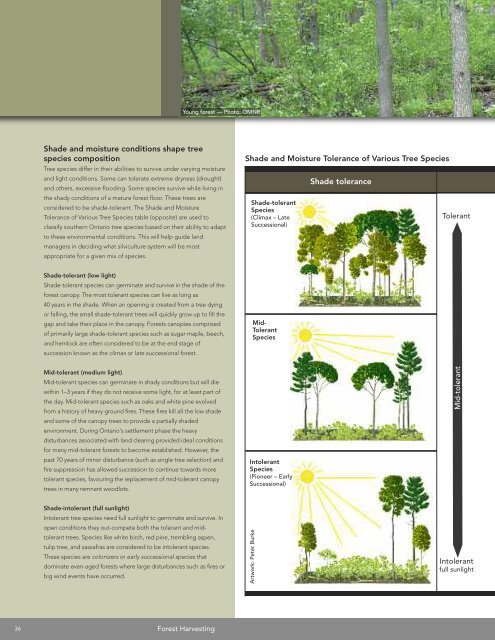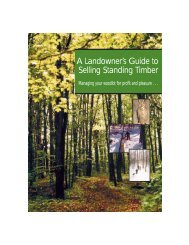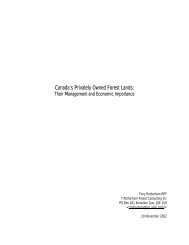A land manager's guide to conserving habitat for forest birds in ...
A land manager's guide to conserving habitat for forest birds in ...
A land manager's guide to conserving habitat for forest birds in ...
You also want an ePaper? Increase the reach of your titles
YUMPU automatically turns print PDFs into web optimized ePapers that Google loves.
Mid-<strong>to</strong>lerant<br />
Young <strong>for</strong>est — Pho<strong>to</strong>: OMNR<br />
Shade and moisture conditions shape tree<br />
species composition<br />
Tree species differ <strong>in</strong> their abilities <strong>to</strong> survive under vary<strong>in</strong>g moisture<br />
and light conditions. Some can <strong>to</strong>lerate extreme dryness (drought)<br />
and others, excessive flood<strong>in</strong>g. Some species survive while liv<strong>in</strong>g <strong>in</strong><br />
the shady conditions of a mature <strong>for</strong>est floor. These trees are<br />
considered <strong>to</strong> be shade-<strong>to</strong>lerant. The Shade and Moisture<br />
Tolerance of Various Tree Species table (opposite) are used <strong>to</strong><br />
classify southern Ontario tree species based on their ability <strong>to</strong> adapt<br />
<strong>to</strong> these environmental conditions. This will help <strong>guide</strong> <strong>land</strong><br />
managers <strong>in</strong> decid<strong>in</strong>g what silviculture system will be most<br />
appropriate <strong>for</strong> a given mix of species.<br />
Shade and Moisture Tolerance of Various Tree Species<br />
Shade-<strong>to</strong>lerant<br />
Species<br />
(Climax – Late<br />
Successional)<br />
Shade <strong>to</strong>lerance<br />
Tolerant<br />
Shade-<strong>to</strong>lerant (low light)<br />
Shade-<strong>to</strong>lerant species can germ<strong>in</strong>ate and survive <strong>in</strong> the shade of the<br />
<strong>for</strong>est canopy. The most <strong>to</strong>lerant species can live as long as<br />
40 years <strong>in</strong> the shade. When an open<strong>in</strong>g is created from a tree dy<strong>in</strong>g<br />
or fall<strong>in</strong>g, the small shade-<strong>to</strong>lerant trees will quickly grow up <strong>to</strong> fill the<br />
gap and take their place <strong>in</strong> the canopy. Forests canopies comprised<br />
of primarily large shade-<strong>to</strong>lerant species such as sugar maple, beech,<br />
and hemlock are often considered <strong>to</strong> be at the end stage of<br />
succession known as the climax or late successional <strong>for</strong>est.<br />
Mid-<br />
Tolerant<br />
Species<br />
Mid-<strong>to</strong>lerant (medium light)<br />
Mid-<strong>to</strong>lerant species can germ<strong>in</strong>ate <strong>in</strong> shady conditions but will die<br />
with<strong>in</strong> 1–3 years if they do not receive some light, <strong>for</strong> at least part of<br />
the day. Mid-<strong>to</strong>lerant species such as oaks and white p<strong>in</strong>e evolved<br />
from a his<strong>to</strong>ry of heavy ground fires. These fires kill all the low shade<br />
and some of the canopy trees <strong>to</strong> provide a partially shaded<br />
environment. Dur<strong>in</strong>g Ontario’s settlement phase the heavy<br />
disturbances associated with <strong>land</strong> clear<strong>in</strong>g provided ideal conditions<br />
<strong>for</strong> many mid-<strong>to</strong>lerant <strong>for</strong>ests <strong>to</strong> become established. However, the<br />
past 70 years of m<strong>in</strong>or disturbance (such as s<strong>in</strong>gle tree selection) and<br />
fire suppression has allowed succession <strong>to</strong> cont<strong>in</strong>ue <strong>to</strong>wards more<br />
<strong>to</strong>lerant species, favour<strong>in</strong>g the replacement of mid-<strong>to</strong>lerant canopy<br />
trees <strong>in</strong> many remnant woodlots.<br />
In<strong>to</strong>lerant<br />
Species<br />
(Pioneer – Early<br />
Successional)<br />
Shade-<strong>in</strong><strong>to</strong>lerant (full sunlight)<br />
In<strong>to</strong>lerant tree species need full sunlight <strong>to</strong> germ<strong>in</strong>ate and survive. In<br />
open conditions they out-compete both the <strong>to</strong>lerant and mid<strong>to</strong>lerant<br />
trees. Species like white birch, red p<strong>in</strong>e, trembl<strong>in</strong>g aspen,<br />
tulip tree, and sassafras are considered <strong>to</strong> be <strong>in</strong><strong>to</strong>lerant species.<br />
These species are colonizers or early successional species that<br />
dom<strong>in</strong>ate even-aged <strong>for</strong>ests where large disturbances such as fires or<br />
big w<strong>in</strong>d events have occurred.<br />
Artwork: Peter Burke<br />
In<strong>to</strong>lerant<br />
full sunlight<br />
36<br />
Forest Harvest<strong>in</strong>g

















